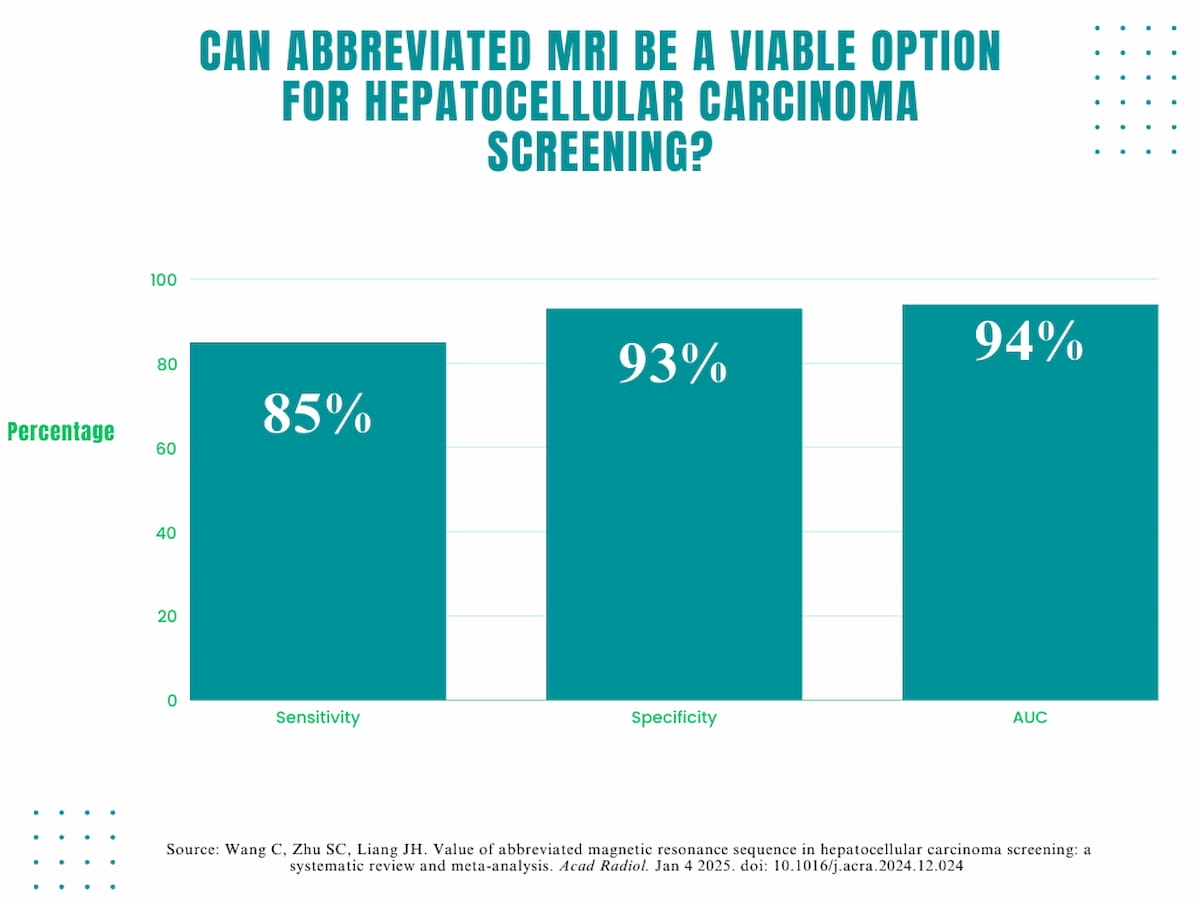Abbreviated magnetic resonance imaging (AMRI) may offer significant utility in screening for hepatocellular carcinoma, according to a newly published meta-analysis.
For the meta-analysis, recently published in Academic Radiology, researchers reviewed AMRI data from 19 studies and a total of 3.914 study participants.
The meta-analysis authors found that AMRI provided aggregate sensitivity of 85 percent, specificity of 93 percent and an area under the curve (AUC) of 94 percent.
“ … In recent years, the use of a small number of sequences has been proposed as an abbreviated alternative to full-sequence MRI for screening, with the aim of reducing the time and economic cost of screening while ensuring high diagnostic efficacy. In the present meta-analysis, the diagnostic efficacy of AMRI was similar to that of previous screening with complete-sequence MRI, with sensitivities of 85% and 86% and specificities of 93% and 97%, respectively,” wrote lead study author Cong Wang, M.M., who is affiliated with the Department of Medical Imaging at the Henan Provincial People’s Hospital in Zhengzhou, China, and colleagues.
The AMRI series of T2-weighted MRI, diffusion-weighted imaging (DWI) and hepatobiliary phase (HBP) imaging offered the most optimal sequencing protocol with pooled sensitivity of 88 percent, specificity of 93 percent and an AUC of 96 percent, according to the meta-study authors.
“The increased contrast between liver parenchyma and liver cancer lesions in the hepatobiliary-specific phase is more favorable for small lesion detection, (and) the combined T2WI and DWI images may provide early image information of lesions in high-risk groups undergoing screening to help clinical assessment and timely treatment of the disease and improve patient prognosis,” noted Wang and colleagues.
Three Key Takeaways
1. High diagnostic efficacy. Accelerated MRI (AMRI) demonstrated diagnostic performance comparable to full-sequence MRI, with pooled sensitivity of 85 percent in contrast to 88 percent and specificity of 93 percent versus 97 percent, offering reliable detection of HCC lesions while reducing scan time and cost.
2. Enhanced small lesion detection. The combination of T2-weighted MRI (T2WI), diffusion-weighted MRI (DWI) and hepatobiliary phase (HBP) imaging provided the most optimal AMRI protocol. The HBP imaging improves contrast for small lesion detection, while the combination of T2WI and DWI offers early lesion visualization. The combined AMRI sequencing achieved pooled sensitivity of 88 percent and specificity of 93 percent.
3. Alternative to ultrasound for screening. AMRI was found to have a 30 percent higher sensitivity than ultrasound (81 percent vs. 51 percent) for HCC surveillance, making it a viable and potentially superior alternative for clinical screening programs.
For hepatocellular carcinoma, the researchers added that a comparative study of AMRI and ultrasound revealed a 30 percent higher sensitivity for AMRI (81 percent vs. 51 percent).
“Based on previous studies and the results of our meta-analysis, AMRI offers fewer scan sequences, lower time and economic costs, and higher diagnostic efficacy, suggesting that AMRI might be used as an alternative tool to ultrasound for HCC surveillance in clinical screening,” posited Wang and colleagues.
(Editor’s note: For related content, see “New CT and MRI Research Shows Link Between LR-M Lesions and Rapid Progression of Early-Stage HCC,” “Comparative Study Says Enhanced MRI Offers Optimal Detection of Neuroendocrine Tumor Liver Metastases” and “Deep Learning Model with DCE-MRI May Help Predict Proliferative Hepatocellular Carcinoma.”)
In regard to limitations of the meta-analysis, the authors acknowledged a low number of prospective comparative studies examining AMRI and ultrasound for hepatocellular carcinoma. The researchers noted the majority of reviewed research with AMRI involved retrospective studies and high-risk populations with an overrepresentation of cirrhosis. The meta-analysis authors also pointed out a lack of studies offering combined analysis of the diagnostic capabilities and cost-effectiveness of AMRI.
